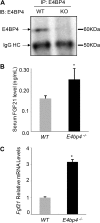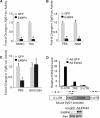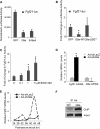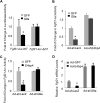Recruitment of histone methyltransferase G9a mediates transcriptional repression of Fgf21 gene by E4BP4 protein
- PMID: 23283977
- PMCID: PMC3581381
- DOI: 10.1074/jbc.M112.433482
Recruitment of histone methyltransferase G9a mediates transcriptional repression of Fgf21 gene by E4BP4 protein
Abstract
The liver responds to fasting-refeeding cycles by reprogramming expression of metabolic genes. Fasting potently induces one of the key hepatic hormones, fibroblast growth factor 21 (FGF21), to promote lipolysis, fatty acid oxidation, and ketogenesis, whereas refeeding suppresses its expression. We previously reported that the basic leucine zipper transcription factor E4BP4 (E4 binding protein 4) represses Fgf21 expression and disrupts its circadian oscillations in cultured hepatocytes. However, the epigenetic mechanism for E4BP4-dependent suppression of Fgf21 has not yet been addressed. Here we present evidence that histone methyltransferase G9a mediates E4BP4-dependent repression of Fgf21 during refeeding by promoting repressive histone modification. We find that Fgf21 expression is up-regulated in E4bp4 knock-out mouse liver. We demonstrate that the G9a-specific inhibitor BIX01294 abolishes suppression of the Fgf21 promoter activity by E4BP4, whereas overexpression of E4bp4 leads to increased levels of dimethylation of histone 3 lysine 9 (H3K9me2) around the Fgf21 promoter region. Furthermore, we also show that E4BP4 interacts with G9a, and knockdown of G9a blocks repression of Fgf21 promoter activity and expression in cells overexpressing E4bp4. A G9a mutant lacking catalytic activity, due to deletion of the SET domain, fails to inhibit the Fgf21 promoter activity. Importantly, acute hepatic knockdown by adenoviral shRNA targeting G9a abolishes Fgf21 repression by refeeding, concomitant with decreased levels of H3K9me2 around the Fgf21 promoter region. In summary, we show that G9a mediates E4BP4-dependent suppression of hepatic Fgf21 by enhancing histone methylation (H3K9me2) of the Fgf21 promoter.
Figures







Similar articles
-
E4BP4/NFIL3 modulates the epigenetically repressed RAS effector RASSF8 function through histone methyltransferases.J Biol Chem. 2018 Apr 13;293(15):5624-5635. doi: 10.1074/jbc.RA117.000623. Epub 2018 Feb 21. J Biol Chem. 2018. PMID: 29467226 Free PMC article.
-
Transcriptional repressor E4-binding protein 4 (E4BP4) regulates metabolic hormone fibroblast growth factor 21 (FGF21) during circadian cycles and feeding.J Biol Chem. 2010 Nov 19;285(47):36401-9. doi: 10.1074/jbc.M110.172866. Epub 2010 Sep 17. J Biol Chem. 2010. PMID: 20851878 Free PMC article.
-
E4BP4 promotes thyroid cancer proliferation by modulating iron homeostasis through repression of hepcidin.Cell Death Dis. 2018 Sep 24;9(10):987. doi: 10.1038/s41419-018-1001-3. Cell Death Dis. 2018. PMID: 30250199 Free PMC article.
-
Postnatal exercise protects offspring from high-fat diet-induced reductions in subcutaneous adipocyte beiging in C57Bl6/J mice.J Nutr Biochem. 2022 Jan;99:108853. doi: 10.1016/j.jnutbio.2021.108853. Epub 2021 Sep 11. J Nutr Biochem. 2022. PMID: 34517093 Free PMC article.
-
E4BP4: an unexpected player in the immune response.Trends Immunol. 2012 Feb;33(2):98-102. doi: 10.1016/j.it.2011.10.002. Epub 2011 Nov 8. Trends Immunol. 2012. PMID: 22075207 Review.
Cited by
-
Alcohol and Liver Clock Disruption Increase Small Droplet Macrosteatosis, Alter Lipid Metabolism and Clock Gene mRNA Rhythms, and Remodel the Triglyceride Lipidome in Mouse Liver.Front Physiol. 2020 Sep 7;11:1048. doi: 10.3389/fphys.2020.01048. eCollection 2020. Front Physiol. 2020. PMID: 33013449 Free PMC article.
-
E4BP4/NFIL3 modulates the epigenetically repressed RAS effector RASSF8 function through histone methyltransferases.J Biol Chem. 2018 Apr 13;293(15):5624-5635. doi: 10.1074/jbc.RA117.000623. Epub 2018 Feb 21. J Biol Chem. 2018. PMID: 29467226 Free PMC article.
-
Liver clock protein BMAL1 promotes de novo lipogenesis through insulin-mTORC2-AKT signaling.J Biol Chem. 2014 Sep 12;289(37):25925-35. doi: 10.1074/jbc.M114.567628. Epub 2014 Jul 25. J Biol Chem. 2014. PMID: 25063808 Free PMC article.
-
The Role of Fibroblast Growth Factor 21 in Diabetic Cardiovascular Complications and Related Epigenetic Mechanisms.Front Endocrinol (Lausanne). 2021 Jul 19;12:598008. doi: 10.3389/fendo.2021.598008. eCollection 2021. Front Endocrinol (Lausanne). 2021. PMID: 34349728 Free PMC article. Review.
-
The role of basic leucine zipper transcription factor E4BP4 in cancer: a review and update.Mol Biol Rep. 2024 Jan 9;51(1):91. doi: 10.1007/s11033-023-09079-9. Mol Biol Rep. 2024. PMID: 38193973 Review.
References
-
- Badman M. K., Pissios P., Kennedy A. R., Koukos G., Flier J. S., Maratos-Flier E. (2007) Hepatic fibroblast growth factor 21 is regulated by PPARα and is a key mediator of hepatic lipid metabolism in ketotic states. Cell Metab. 5, 426–437 - PubMed
-
- Inagaki T., Dutchak P., Zhao G., Ding X., Gautron L., Parameswara V., Li Y., Goetz R., Mohammadi M., Esser V., Elmquist J. K., Gerard R. D., Burgess S. C., Hammer R. E., Mangelsdorf D. J., Kliewer S. A. (2007) Endocrine regulation of the fasting response by PPARα-mediated induction of fibroblast growth factor 21. Cell Metab. 5, 415–425 - PubMed
Publication types
MeSH terms
Substances
Grants and funding
LinkOut - more resources
Full Text Sources
Other Literature Sources
Molecular Biology Databases

